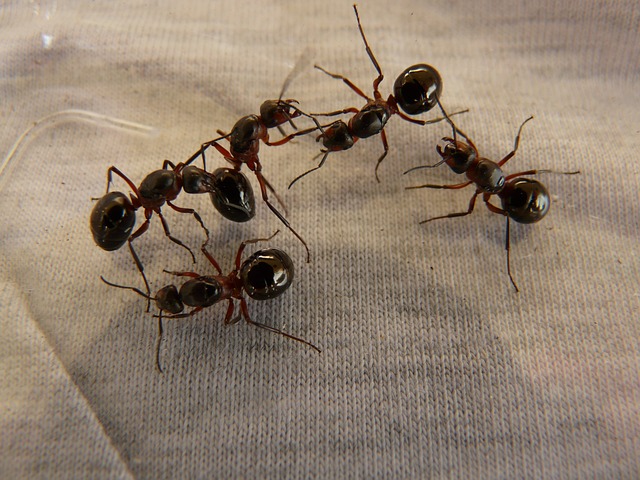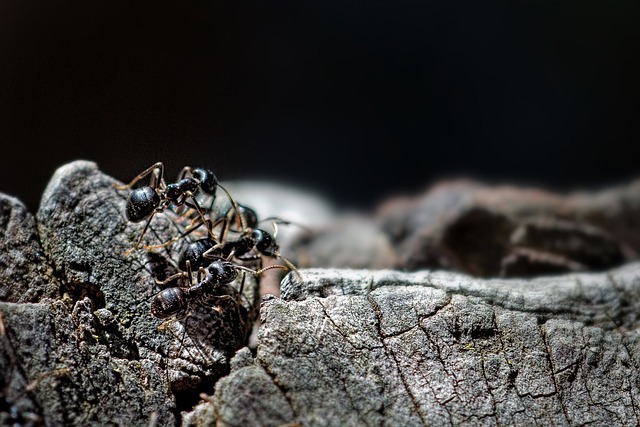Ants are everywhere. They’re social insects that work together in huge colonies, and when they find a way into your home, they don’t come alone. If you want to keep ants out, you need to know why they go in and what you can do to stop them by learning basic ant behavior.

Why Ants Invade Homes
Ants enter homes because they need food and water. They’re always searching for new sources, and your kitchen or bathroom can be a goldmine.
Ants can also be drawn inside by changes in weather. Heavy rain, drought, or extreme heat can drive them indoors as they look for shelter and reliable resources. Once inside, they can nest in walls, under floors, or even behind appliances, making them tough to remove without a plan.
How Ants Find Their Way In
Ants are tiny, so they don’t need much of a gap to get inside. Even the smallest crevice can be enough for a determined ant scout.
Their ability to communicate using pheromones is what makes them so persistent. When one ant finds a way in, it quickly tells the others, and soon you have a steady stream. This is why stopping just one or two ants isn’t enough, you need to address how they’re getting in and why they’re coming.
Making Your Home Less Attractive to Ants
The first step to preventing ant invasions is to make your home less appealing by keeping food and water sources away from them. Even a small crumb or drip can attract ants looking for moisture.
Blocking Ant Entry Points
Here’s a simple ant infestation prevention tip: ants can’t invade if they can’t get inside. Keep your home sealed and shut tight, and make sure to check these regularly, especially after storms or temperature changes, as weather can cause materials to shift and create new gaps. By making it harder for ants to get in, you cut off their access before they even spot a food source.
Disrupting Scent Trails
Ants rely on scent trails to guide the colony to food. When you see a line of ants, you’re seeing their communication system in action. Disrupting these trails can break the cycle and stop more ants from following.
Use a mixture of soap and water to wipe down surfaces where ants have been seen. This removes the pheromone trail and confuses the ants. Vinegar and water can also work, and it has the added benefit of being safe for most surfaces.
If you use natural deterrents like cinnamon, coffee grounds, or citrus peels, place them near entry points or along known trails. These strong scents can mask or disrupt the ants’ chemical signals.
Landscaping and Outdoor Prevention
Ants don’t always start inside. Your yard can be a launching pad for invasions. Keep shrubs, trees, and plants trimmed so they don’t touch your house. Ants use these as bridges to cross into your home, so be careful. Remove dead wood, mulch, or debris close to your foundation, as these can be nesting sites as well.
If you have outdoor pet food or bird feeders, clean up any spills quickly. Fallen fruit in gardens should be picked up, and compost bins should be kept away from the house and sealed tightly.
Using Baits and Traps
When ants are already inside, baits can be effective. Place ant baits where you see activity. THe way these baits work is that ants will carry the bait back to the colony, which helps eliminate the source. Traps can intercept ants before they reach your kitchen or pantry.
It’s important to use baits and traps as directed and to keep them out of reach of children and pets. Baits work best when combined with other strategies like cleaning and sealing entry points.
When to Call a Professional
If you’ve tried cleaning, sealing, and using baits but still see ants, it’s time to bring in an expert. Professionals are trained, equipped, and educated to identify the specific invading ant species, locate nests, and use targeted treatments that get to the root of the problem.
They also provide advice on long-term prevention, helping you avoid future invasions. For severe infestations or hard-to-reach nests, professional help is often the fastest and most reliable solution.
Long-Term Habits for an Ant-Free Home
Keeping ants out isn’t a one-time fix. It takes ongoing effort. Regular cleaning, checking for new entry points, and staying on top of repairs all help keep your home less inviting to ants. Inspect your home every few months. You can time it with the start of a new season so you don’t have to constantly remind yourself.
Conclusion
Ants are persistent, but they’re not unstoppable. When you know what they want and how they work, you can take steps that make your home a dead end for any wandering scout. Clean up food and water, block entry points, disrupt their scent trails, and keep your yard tidy. If you’re facing a stubborn infestation, a pest control expert can solve the problem and keep it from coming back.

